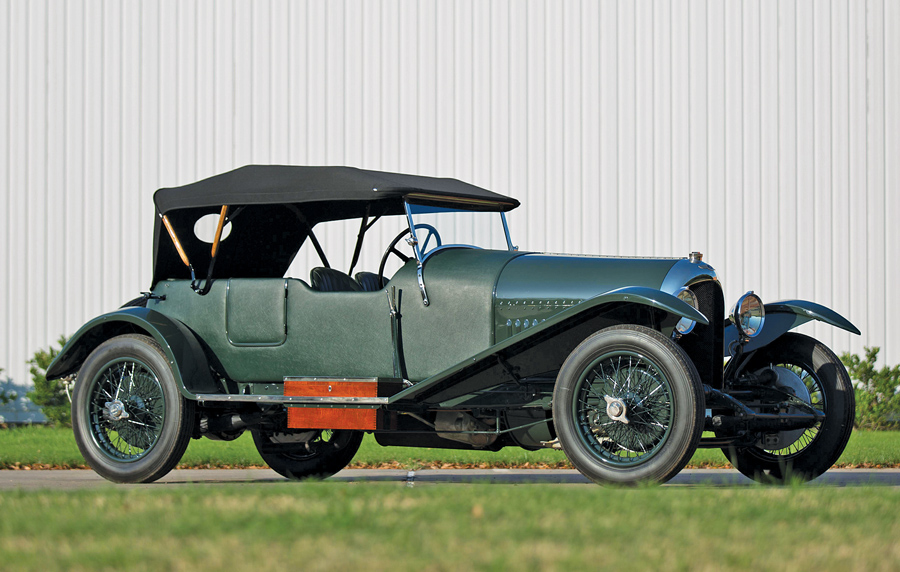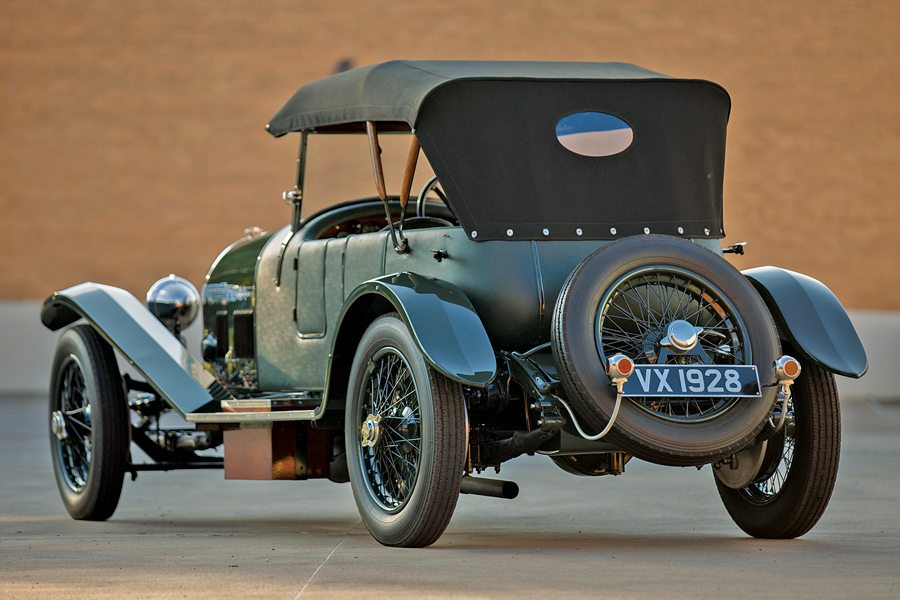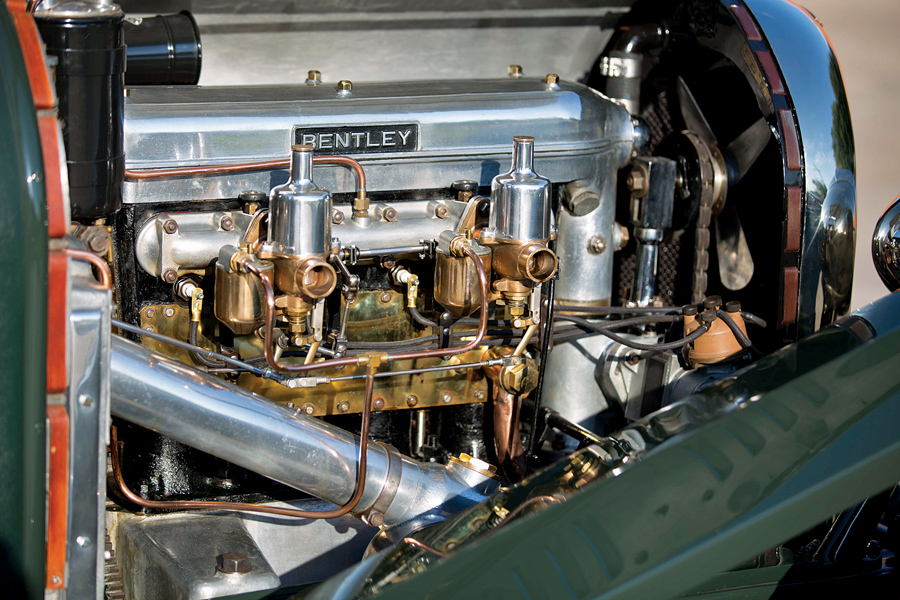- 2,996-cc, SOHC 4-cylinder engine with four valves per cylinder
- Two SU “Sloper” carburetors
- 70 bhp at 3,500 rpm
- 4-speed close-ratio gearbox
SCM Analysis
Detailing
| Vehicle: | 1925 Bentley 3 Litre tourer |
| Years Produced: | 1922–29 |
| Number Produced: | 1,613 |
| Original List Price: | £895 ($4,895) plus coachwork |
| SCM Valuation: | $443,900 |
| Tune Up Cost: | $800–$1,500 |
| Chassis Number Location: | Atop front left corner of forward cross member and in front left hand chassis knuckle |
| Engine Number Location: | Atop left side rearward engine mount/starter motor mount |
| Club Info: | Bentley Drivers Club |
| Website: | http://www.bdcl.org |
| Alternatives: | 1925–27 Vauxhall 30-98, 1928 Alfa Romeo 6C 1500 Sport, 1926–27 Bugatti Type 38 |
| Investment Grade: | A |
This car, Lot 158, sold for $272,250, including buyer’s premium, at Bonhams’ Greenwich, CT, sale on June 4, 2017.
One would be hard pressed to find a less-expensive 3 Litre Bentley, and for roughly $275,000, a less-expensive entry to countless international events. But for a long time now, a vintage Bentley (1919–31) has been an undervalued option when compared to its Bugatti, Mercedes-Benz and Alfa Romeo contemporaries.
While some highly desirable examples of the marque have garnered seven figures for well over a decade, the majority of vintage Bentleys have remained relatively attainable — the subject vehicle being an obvious example.
The buyer got a great deal — a lot of car for the money.
As the son of a vintage-Bentley expert, I’m fairly knowledgeable on the subject myself, and since the auction I’ve had a lot of inquiries as to the result.
Why such a deal?
People seem to agree that the car was well bought. And given the condition, overall appearance and numbers-matching chassis, the buyer got a lovely little Bentley at entry-level pricing. But why was it so well bought?
There are just a few simple reasons why this car may be the new bottom marker in the market.
For starters, the car is a Standard (Blue Label) chassis, and not a Speed Model (Red Label).
The Speed Model boasted a nine-foot, nine-inch chassis, dual carburetion, and many less-obvious mechanical attributes that made it the superior sporting car over the Standard chassis.
The Standard, by contrast, was a 10-foot, 10-inch chassis. The engine was equipped with a single updraft carburetor, in keeping with the model’s lesser tune. By nature, the Standard chassis were commonly fitted with formal coachwork, and the Speed Model was often delivered in sports tourer form.
For decades, the Standard 3 Litre has been the more inexpensive of vintage Bentley variants.
Very plainly, the Speed Model is the more rare variant, and it is much more desirable. A Speed Model can command as much as double the price of a Standard of equal quality.
Furthermore, our subject Bentley’s non-original coachwork — and frankly, the style of the coachwork — makes for diminished collectability and desirability. While the numbers-matching box can be ticked with this particular car, original body cannot.
Original engine vs. original body
Some may disagree, but I value (monetarily and otherwise) an original body far more than an original engine. While I firmly believe that, in this case, having the original engine is important, it is still simply a mechanical component.
By contrast, the coachwork is the car. The coachwork best defines to a greater degree how rare, attractive and original a car can be.
When it comes to vintage Bentleys, however, replacement coachwork and non-matching engines are all too common, and in some cases, all major components are non-original — or non-matching. This situation is so common that it is a challenge to understand an individual car’s place in the market.
They don’t all look alike
Perhaps the most common misconception with vintage Bentleys is that they all looked like the Vanden Plas Le Mans team cars when new. Today, the most commonly seen vintage Bentley is a “VdP Le Mans Replica” (a car rebodied to look like the factory race cars of the period), so the confusion is understandable.
People are forgiving of non-original coachwork on Bentleys. While this is sad, it’s commonplace.
Each of us values an engine change or a rebody differently; our tolerances are different. And, often, what we’re looking for in a car is just different. To many, a rebodied Bentley is precisely what they arelooking for. And so long as you’re not ripping the original coachwork off of a car to make one, there is nothing wrong with wanting a Le Mans replica.
However, it’s important to remember that not all rebodied cars are created equal.
Not a Vanden Plas car
The coachwork on our subject car was done in the style of Jarvis. While Jarvis bodied a number of vintage Bentleys in period, the company’s name recognition pales in comparison to that of Vanden Plas, which is the most recognizable and preferred coachbuilder of sporting Vintage Bentleys.
I don’t intend to say the Jarvis style body on this particular example is unattractive. I mean to say it is less desirable to the broader market. Frankly, I thought it was refreshing to see something a bit different.
The majority of individuals looking to buy a Bentley, particularly one that has been rebodied, however, are inclined to buy a Vanden Plas car. In the context of this 3 Litre, I think it would have garnered more attention had it been rebodied in Vanden Plas fashion.
Bentley confusion
For many first-time Bentley buyers, the abundance of non-original examples is confusing.
For example, cars exist today that carry the original body off of another Bentley.
There are cars with engines swaps, while others motor on with replacement engines built from remanufactured parts.
Steering boxes, front axles, rear axles, gearboxes, bodies, frames and engines all carry their own number stamping (some in multiple places). When these components get swapped around, it’s hard to sort out what is what.
The point is, we can’t understand the Bentley market as a collection of data points when each individual result is hard to characterize so simply.
So while the subject vehicle has been rebodied, it does appear to be very genuine from a chassis-component standpoint. It’s important to note that’s a big value add.
A ticket to enter
Caveats aside, this 3 Litre still offers the buyer entry to many premier international events, with the exception, perhaps, of some very high-level concours. To look at this result in broader terms, for $275,000 one would be challenged to find a less-expensive entry ticket to prestige tours or shows.
As the Bonhams catalog notes, vintage Bentleys have gained popularity in recent years. Bluntly, when you’re behind the wheel, there is no real difference between an entirely original car and a rebodied collection of parts. That’s the appeal of the Bentley. It doesn’t matter how good it is, or how much you paid — it’s guaranteed to put a smile on your face.
People value what a car affords them in the way of experiences. And I’m happy to see many younger collectors gravitate toward vintage Bentleys. There are few pre-war cars that offer so much for the price.
This Bentley was well bought. For relatively little money in today’s market, the buyer got an incredibly usable, enjoyable and well-regarded automobile. ♦
(Introductory description courtesy of Bonhams.)


